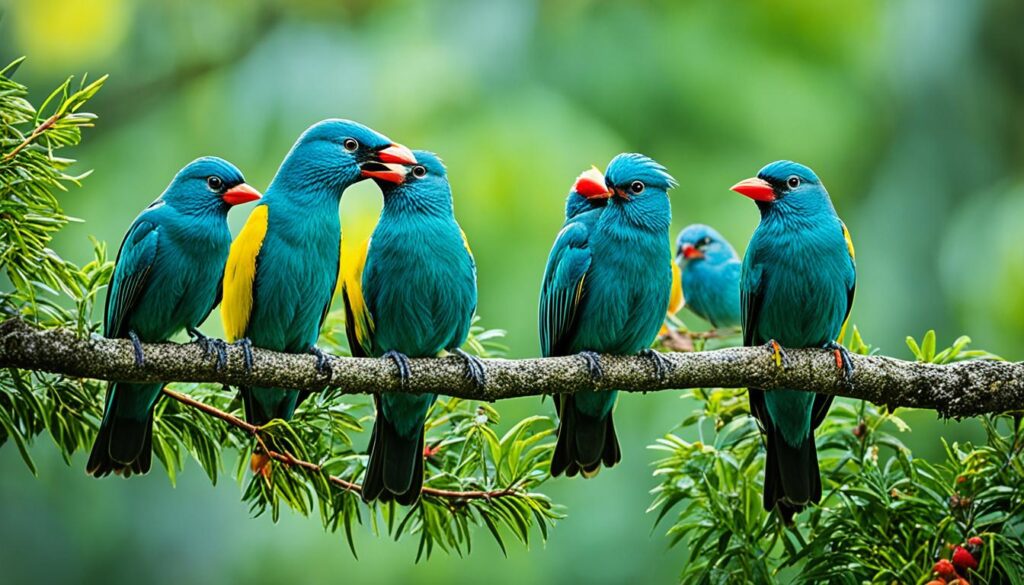Have you ever wondered if birds share where they find food with each other? This question has puzzled bird lovers and scientists for a long time. They’ve discovered that birds use many ways to find food and survive.
Imagine a group of sparrows living in a city garden. They noticed a new bird feeder filled with seeds. At first, they were careful around it. But soon, they started to tell each other about the food through chirps and calls.
This story makes us wonder: do birds really tell each other where to find food? Let’s explore the amazing world of bird communication to find out.
Key Takeaways
- Birds use sounds, sights, and actions to share info with each other.
- Some birds, like corvids and parrots, can share food locations.
- They often share food and info to help each other survive and find food better.
- The place they live and how noisy it is affects how they talk to each other.
- Learning about bird communication helps us understand their smartness, behavior, and the health of nature.
Understanding Bird Communication
Birds use many ways to talk to each other, from singing to showing off with their looks. They have different strategies to send messages, keep friends, and find their way around.
Vocalizations and Calls
Birds make sounds like songs and calls for many reasons. These sounds help them claim their territory, find a mate, warn others of danger, and tell where food is. The way birds make these sounds shows how smart they are at talking to each other.
Visual Signals and Behaviors
Besides making sounds, birds also use visual signals to talk. They show off their feathers, fly in certain ways, and do other things to share info. These signals work with their sounds to help them make decisions and talk to each other.
The Role of Memory and Reciprocity
Birds have great memory and understand the idea of giving back. They can remember and answer specific calls and signals. This helps them work together and share information in their groups.
“Birds have an impressive array of communication methods, from their melodic songs to their captivating visual displays. Understanding these intricate systems provides insights into the fascinating world of avian behavior.”
Observations of Food Sharing Among Birds
Birds often share food info with each other, especially in social groups. They do this because they rely on reciprocity. They tell each other about good food spots, hoping to get tips in return. This helps them survive better.
Scientists have looked into food sharing in birds and social behavior in birds a lot. They’ve found out how birds work together and share food info. This has given us a better look at their foraging strategies and avian communication.
“Over 57 million households in the United States feed backyard birds annually, spending more than $4 billion on bird food.”
A study with 1,176 bird feeders gave us new info on food sharing. It was done with Project FeederWatch, run by the Cornell Lab of Ornithology. The study showed how feeding birds changes things, like more birds coming, or seeing predators or sick birds.
- People reacted by scaring cats, moving feeders, giving birds shelter, and cleaning feeders in different situations.
- Seeing hawks made fewer people act, but most gave birds shelter.
- Feeling angry with cats, sad or worried with sick birds, and mixed feelings with hawks were common.
These studies show how complex bird communication and social behavior are when sharing food resources. As we learn more about birds, these studies help us understand their social lives better.
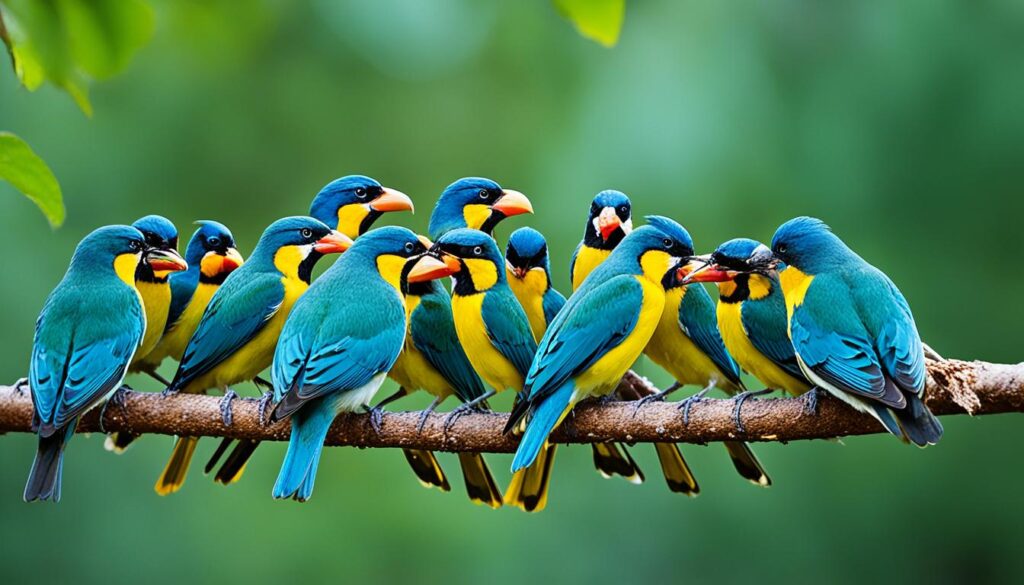
Food Calls: A Common Language for Feeding
The world of bird communication is truly fascinating. It includes the concept of “food calls.” These calls are a common language among birds. They share info about where to find food. Each bird species has its own food call, but they all aim to help find food better.
Birds use food calls to make finding food easier. This cuts down their search time and energy. It helps them survive better. These calls let birds work together to find food.
Birds show off their smart thinking with these food calls. They use vocalizations, visual signals, and behavioral cues to share info. This helps them understand where to find food and meet their nutritional needs.
“Birds communicate with vocal sounds like songs, companion calls & alarm calls, and with visual cues like body language & behavior. Their messages are related to finding mates, tracking friends & family, locating food, staying safe from predators, and defending territories from rival birds.”
Learning about bird food calls is not just interesting. It’s also key for conservation and understanding nature. By exploring this, we learn more about bird relationships and the natural world.
https://www.youtube.com/watch?v=Q2YAVjl3eUA
The Impact of Environment on Communication
The environment greatly affects how birds communicate. Things like the type of habitat and noise levels change how birds use vocal or visual signals. Knowing about these factors helps us understand bird communication better.
Habitat Type and Communication Methods
Birds in dense forests often use vocal signals more. These signals can travel far and aren’t blocked by trees. On the other hand, birds in open areas use visual signals more. This lets them communicate with others over distance.
Noise Levels and Visual vs. Vocal Signals
Noise affects how birds communicate too. In loud places, birds might use visual signals more. This is because vocal signals can get lost in the noise. By choosing visual signals, birds can still send their messages clearly.
Learning how the environment influences bird communication helps us appreciate their complex behaviors. By studying how habitat, noise, and signals interact, we see how clever and adaptable birds are.
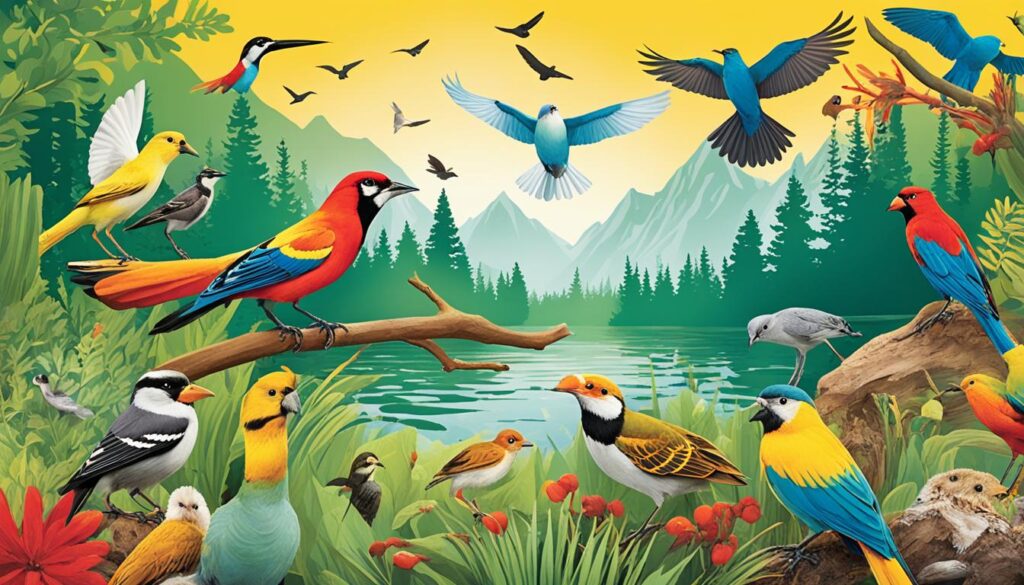
“The book ‘Understanding Bird Behavior: An Illustrated Guide to What Birds Do and Why’ explores how birds find food, why they form nonbreeding relationships, how they respond to threats and danger, and how they adapt certain behaviors based on climate change.”
Do birds tell each other where food is?
The idea that birds tell each other where food is has always caught the interest of birdwatchers and scientists. Studies show that birds do share info about food with their friends. This helps them find food better and survive.
Birds use food calls to tell others about food. These special sounds alert other birds to a good spot. This way, more birds can enjoy the food found by one.
They also use visual signals to share food info. A bird might stand out or move in a certain way to show where food is. This helps its friends find food easily.
Birds can remember and recognize where they found food before. If a bird has eaten well at a spot before, it will likely go back. It will also tell other birds about it.
How birds share food info can differ among species. But the research shows it’s common in birds. Learning about this helps us understand bird communities better.
Garden Birds and Communication
Garden birds offer a peek into the world of bird communication. Feeders in backyards attract many species and change their sounds and actions. But, using feeders can also change how birds talk to each other and behave naturally.
Attracting Birds with Feeders
Bird feeders draw many garden birds to your yard. You can see colorful birds like cardinals and finches, and bigger birds like woodpeckers and jays. A feeder makes your outdoor space lively and lets you watch birds talk to each other.
The Effect of Feeders on Bird Communication
Feeders let us see how backyard birds communicate, but they also change their natural ways. Birds may talk more, fight over the feeder, or act differently around people. Some birds might get more vocal or bold, while others might not be as scared of humans.
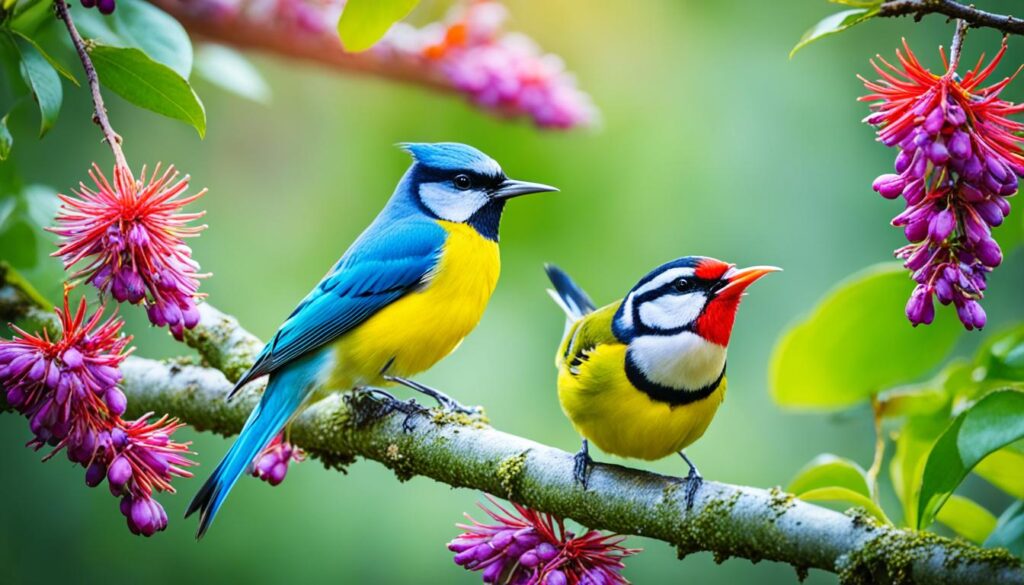
Using bird feeders has big ethical thoughts. We need to balance giving birds extra food with respecting their natural ways. This balance is key for watching birds responsibly.
“The language of birds is very ancient, and, like their music, it has some relation to the order of the universe.” – Henry David Thoreau
Watching garden birds at feeders teaches us about their complex communication. Learning about their sounds, signals, and social life makes us appreciate nature more. It also encourages us to take care of the birds in our yards.
Birds’ Excellent Eyesight and Food Location
Birds are known for their amazing eyesight, which helps them find food. Most birds use their sharp vision to look for food instead of smell. This sharp vision is key to their survival and how they find food.
Studies found that birds have some of the biggest eyes compared to their size among all land animals, just after frogs. A study looked at 2,777 bird species, showing how important vision is for birds.
Birds with larger eyes are often raptors or owls, perfect for seeing well in the dark. Smaller birds usually stay active during the day because their eyes aren’t good for night vision.
Birds see colors, including ultraviolet light, which helps them find food. This lets them see fruits and berries that reflect ultraviolet light, helping them forage better.
“Birds have the largest eyes relative to their size in the animal kingdom, and movement is limited within the eye’s socket.”
Where birds live affects how they communicate. Birds in dense forests have bigger eyes to get more light and find food. Birds in open areas often have smaller eyes to avoid glare.
The amazing bird vision and avian foraging skills show how birds have adapted to survive and find food in different places.
The Role of Smell in Finding Food
Most birds have a weak sense of smell compared to humans. But, some like parrots, kiwis, and vultures have a stronger sense. They use smell to help find food, even though they mostly rely on vision.
Recent studies have shown how important smell is for birds. For example, turkey vultures can smell the scent of ethyl mercaptan to find fresh carcasses. Kiwis use their strong smell to find earthworms underground.
“Birds process visual information much faster than humans, and many possess acute hearing essential for communication, recognizing offspring, and detecting predators and prey.”
Research on bird smell is fascinating. It shows how birds use their senses to find food and navigate. As we learn more about bird smell, we see how important it is for finding food.
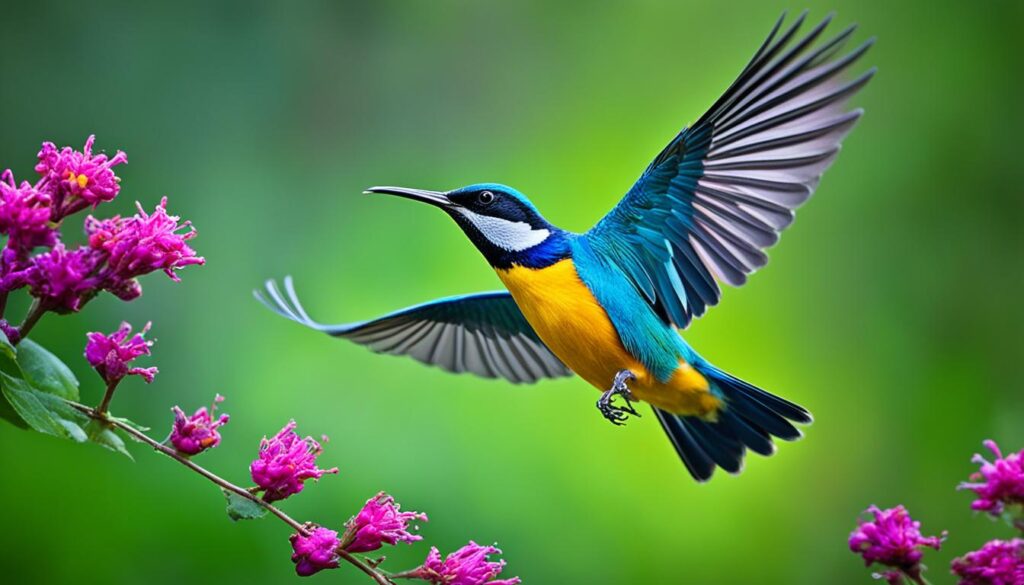
Scientists like Gabrielle Nevitt and Kenneth Stager have made big discoveries. They found out how kiwis and turkey vultures use their smell. These findings help us understand how birds adapt to their environments.
Bird Memory and Recognizing Food Sources
Birds have amazing memories that help them find food, like the feeders in your backyard. They learn when humans put out food and plan their visits. This shows how smart they are at adapting to our routines.
Familiar Feeders and Human Routines
Some birds, like crows and robins, can recognize human faces and voices. Crows even remember people’s faces, even if they wear different clothes. Pigeons can tell who you are and act differently if you’ve met before.
American Robins know when humans fill feeders and birdbaths. They go to places where they can count on finding food or water. This shows how good they are at remembering where to find food and adapting to our schedules.
Human actions affect how birds communicate. For example, starlings won’t come to feed if a person looks at their dish. But they come back when the person looks away. Crows also don’t like being stared at and will fly away quickly.
To get along with wild birds, be patient and respectful. Speak softly and move slowly. Keep pets away and get closer over time. This way, you can connect with birds and see how smart they are.
“Birds, such as American Robins, pay attention to human schedules for filling feeders and birdbaths.”
Birds are smart in the wild too, not just in cities. A study found that chickadees in Alaska have better memory because of their brain structure. This helps them find food better than chickadees in Colorado. It shows how birds adapt to their environment.
Attracting Birds to New Feeders
Adding a new bird feeder to your yard is thrilling, but it might take time for birds to find it. With the right steps, you can make your feeder more appealing to them.
Tips for Success
Here are some tips to attract birds to your new feeder:
- Placement is key – put the feeder where birds can easily see and reach it, away from strong winds and predators.
- Use high-quality, fresh seed mixes that the birds in your area like. Sunflower seeds, nyjer, and safflower are good choices.
- Make sure there’s a water source, like a birdbath or shallow dish, near the feeder for thirsty birds.
- Add trees, shrubs, and perches around the feeder for birds to feel safe and sheltered.
- Be patient and keep feeding. It might take time, but birds will learn to visit your feeder regularly.
By using these backyard bird feeding strategies, you can make your yard welcoming for birds. This will help attract birds to new feeders and make successful bird feeding a reality in your outdoor space.
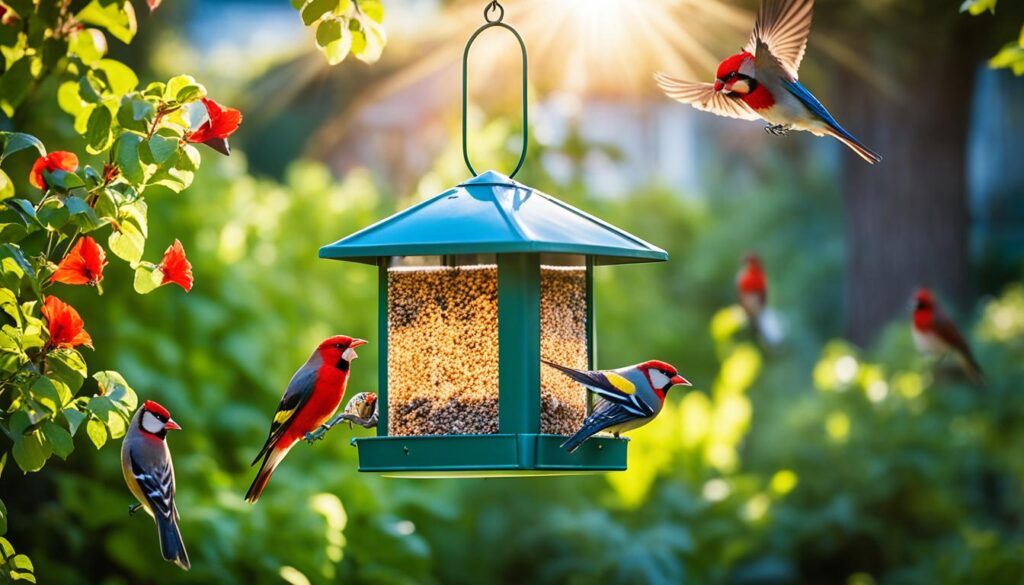
Conclusion
Birds have a complex way of communicating with each other. They use sounds, looks, and actions to share information. This includes where to find food, showing how smart and adaptable they are.
Studying how birds talk to each other helps us understand their social lives and how they think. It also shows how they fit into their environments. This knowledge is key for protecting birds and making cities better for them.
This article shows how birds share info about food in many ways. They use sounds, sights, and memory to help each other out. By learning more about this, we can better care for birds and the world they live in.
FAQ
Do birds communicate information about food sources to their flock mates?
Yes, birds share info about food with each other, especially in groups. This helps them survive by sharing food spots and getting food back later.
How do birds communicate through vocalizations and visual signals?
Birds talk to each other with sounds and looks. They use songs, calls, and feather displays to send messages. They remember these signals and expect others to do the same, helping them work together.
How does the environment impact bird communication methods?
The place where birds live affects how they talk to each other. In dense forests, they use sounds more. In open areas, they use looks more. This helps them communicate better in their surroundings.
What are food calls, and how do they help birds locate food sources?
Food calls are special sounds birds make to tell others where food is. Each bird type has its own call for this. It helps them find food faster and spend less time looking.
How do bird feeders affect bird communication and behavior?
Bird feeders can bring many birds together and change how they talk and act. But, using feeders can also mess with their natural ways of communicating and behaving.
How do birds use their senses to locate food sources?
Most birds use their great eyesight to find food. But, some like parrots and vultures also use their smell to help find food.
How do birds remember the location of food sources, including bird feeders?
Birds have great memories for remembering where to find food, like bird feeders. They can also learn when humans put out food, helping them plan their visits.
How can you attract birds to a new feeder in the garden?
To get birds to a new feeder, place it right and use good seed. It might take time for them to find it, but with the right setup, your garden can become a bird paradise.
